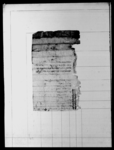A rukkā from King Raṇabahādura exempting certain Kathmandu goldsmiths from corvée (VS 1840)
ID: DNA_0014_0026
Edited and
translated by Rajendra Shakya
Created: 2017-11-06;
Last modified: 2020-11-23
For the metadata of the document, click here
The accompanying edition, translation/synopsis and/or commentary are available under the terms of the Creative Commons Attribution-ShareAlike 4.0 International License
Abstract
In this executive order (rukkā), King Raṇabahādura exempts a total of 75 households of goldsmiths from Kathmandu from corvée for as long as they mint silver coins.Diplomatic edition
[1r]
1श्रीदुर्गास[?]\ [Royal seal]1स्वस्तिश्रीमन्महारा[?]जकस्यरुक्का===2आगे∙सहरकाठमाडौँकाचाँदिकाटक्सारकावाँ
3डाघर७५के∙टक्सारकोकामतिमिहरुलेगरं
4ज्यासम्मझारावेठ्वेगारमाफगरिवक्स्यौं∙
[table1]
| 1 | नाएक∙धंचादेव़∙लक्ष्मिनारां∙जना | ३ |
| 2 | लगंटोलकोघर | १८ |
| 3 | गोफलेटोलकोघर | १३ |
| 4 | इकुवाहाटोलकोघर | ४ |
| 5 | ञँटाषाटोलकोघर | १ |
| 6 | सिषमुगटोलकोघर | ६ |
| 7 | असंटोलकोघर | ५ |
| 8 | इटुंवाहाटोलकोघर | १९ |
| 9 | कोहिटिटोलकोघर | १ |
| 10 | नौघलटोलकोघर | २ |
5इतिसम्वत्१८४०सालजेष्टवदि६रोज शुभम्===
[1v]
1⟪४४७⟫2⟪(४३)⟫1मार्फत्तहसिलियादिवानभिम
2षवासषजांचीगर्भुषवास====
Translation
[1r]
[May] Śrī Durgā help [us].
[Royal seal]
Hail! A rukkā issued by the venerable supreme king of great kings.1
Āge: To 75 households of Bā̃ḍās of the city of Kathmandu [working] at the silver mint (ṭakasāra).
We have exempted [you] from jhārā, beṭh and begāra corvée for as long as you keep working at the mint.
Particulars (tapasila)
[table1]
| The leaders (nāike, text: nāeka) Dhaṃcā, Deva [and] Lakṣṃinārāṃ, persons | 3 | |
| Households of Lagaṃ Ṭola | 18 | |
Households of Gophale Ṭola | 16 | |
| Households of Ikubāhā Ṭola | 4 | |
| Household of Ñaṭākhā Ṭola | 1 | |
| Households of Sikhamuga Ṭola | 6 | |
| Households of Asaṃ Ṭola | 5 | |
| Households of Iṭuṃbāhā Ṭola | 19 | |
| Household of Kohiṭi Ṭola | 1 | |
| Households of Naughala Ṭola | 2 |
[Thurs]day, the 6th of the dark fortnight of Jyeṣṭha in the [Vikrama] era year 1840 (1783 CE). Auspiciousness.
[1v]
[no.] 4472
(43)3
Through the devāna of the tahasila, Bhīma Khavāsa, [and] KhajāncīGarbhu Khavāsa
Commentary
Nepal has a long history of minting silver coins. In fact, the earliest coins found in the Kathmandu Valley are two silver punch-marked pieces of the type that circulated extensively in northern India until the third century CE (Rhodes et al. 1989: 14). As this document shows, King Raṇabahādura continued in this tradition employing a large number of households of Bā̃ḍās from Kathmandu to mint silver coins. Such coins were important back then, as the smaller silver coins were considered more convenient than copper coins of the same denomination (Hamilton 1819: 215). This document was issued about five years ahead of the Sino-Nepalese war (1788–1792), which broke out over a dispute relating to silver coins used in Tibet that were minted in Nepal.
Of the 75 households that received the exemption from corvée, the document lists only three by name: those of Dhaṃcā, Deva and Lakṣminārāṃ, who possibly had the main responsibility of overseeing the minting process. The others are referred to only in terms of the number of households from specified locations.


